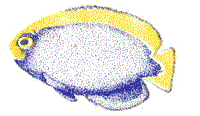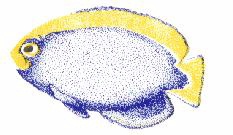|
An Alternate Method for Treating Bacterial and Fungal Infections in
Seahorses
By Chris Burns
INTENTION
This article is intended to provide a possible alternative remedy for
the bacterial and fungal infections common in captive seahorses.
It must be noted that any results put forth in this article are purely
anecdotal and not empirical.
BACKGROUND
As keepers of seahorses, we may find ourselves, and our charges, battling
dermal bacterial and/or fungal infections. Often times, bacteria,
being highly opportunistic, will cause a secondary infection to an existing
fungal infection, or any wounds suffered from erosions, bites, scratches
or tears of the epidermis for that matter. Commonly, we treat with
broad-spectrum antibiotics that have the ill effect of decimating the nitrifying
bacteria culture present in an established tank, which create a toxic ammonia
spike that can, at the least, cause serious stress on an already sick animal
and at worst, outright kill the patient. Hospital tanks are sometimes
set-up and used to remove the sick animal and treat it in isolation, but
with seahorses, the lack of companionship and natural environment associated
with the sterility of a hospital tank can be equally detrimental.
This idea was born when I purchased a female yellow Brazilian horse
(Hippocampus reidi) from my LFS that had the telltale pinkish eroded spot
of Snout Rot. Although my LFS is very good, she had been there for
at least 12 days and I was sure she would not make it in their holding
tank, so I took her home. I observed this spot for 3-4 days while
she was in my care and after noticing that the spot was growing and darkening
slightly, I decided to treat her. Within 14 hours of the commencement
of treatment (3 total treatments), I noticed the pink spot losing color
and diminishing in size. I must admit that I ended up losing her
several days later to an unknown cause, but at the time of her demise,
the visible signs of the Snout Rot were all but gone. It must be
noted that she may have died as a result of formaldehyde or iodine poisoning
or from unseen complications due to the Snout Rot. I find poisoning
in this case to be very unlikely as I was very careful not to allow any
of the solution to enter her mouth, and there were no signs of any distress
for a few days after the treatment. She was in my care for a total
of 10 days.
DETAIL OF TREATMENT
As an alternative method of treating these bacterial/fungal infections,
I propose the following topical solution, to be administered directly to
the effected areas with a cotton swab:
1. Take 1/8 cup of tank water
2. Mix in 10 drops of 2% tincture of iodine solution (I used Brite-Life
brand which is 2% iodine, 47% alcohol, 2.4% sodium iodine and 48.6% purified
water)
3. Mix in 10 drops of Formalin (I used Kordon brand Formalin3
which is a < 3% formaldehyde solution)
Using a cotton swab to deliver the solution, the seahorse can be removed
from the tank by gently grasping its body. Exercise caution not to
touch infected areas that you will not spread the infection. The
solution should be given approximately 5-10 seconds to absorb into the
wound. After this time, the horse can be released back into the tank.
If your horse is affected on the body or tail, you can hold the animal
underwater with just the infected area exposed to the air. This will
help to keep them calm, and allow more time for the solution to work.
Treatment should be performed 3 times a day until noticeable improvement
is shown or 5 days have elapsed. If your patient is not showing signs
of improvement after 5 days, but is still hanging on, then the treatment
is too dilute. You may wish to make a 50% to 100% stronger solution
and continue. In this event, it is highly recommended that you begin
a course of antibiotics in order to improve your chances of restoring the
animal to full health.
ADDITIONAL DETAILS
As of the writing of this article, I have had the opportunity to treat
another horse for bacterial/fungal infection. Another female H. reidi
developed a pinkish-gray spot at the base of her tail, where it meets the
body. I immediately began treatment with a new revision of the solution
(see formula below), and within 4 treatments, administered over 2 days,
the spot was beginning to recede. Again, I must note that on the
5th treatment, I noticed two other spots adjacent to the original, which
could have been due to my own spreading of the infection or natural spreading.
I opted, after losing my other female H. reidi, to place this one in a
med tank. My observations of her in the tank are that she is much
more stressed and less happy than she was in her home even with me occasionally
removing her to apply the solution.
The new solution is mixed by the following recipe:
1. Take 1/8 cup of tank water
2. Mix in 15 drops of Kent Marine Tech-D coral dip
3. Mix in 15 drops of Formalin (I used Kordon brand Formalin3
which is a < 3% formaldehyde solution)
The Kent Marine Tech-D product has Potassium Iodide and Potassium Bromide,
which are both excellent anti-microbial agents, and are much stronger than
elemental iodine or sodium iodine. If this product is unavailable,
it is recommended that you use Betadine, which is iodine/povodine in a
solution that liberates more free elemental iodine to the wound, making
it much more potent than the originally mentioned medicinal iodine solution.
It should be noted that these mixtures should be diluted to reduce the
chances of chemical burns to the patient. I recommend that a minimum
of 1/7 of the solution be tank water (i.e. 3 parts Formalin, 3 parts iodine/betadine/Tech-D
and 1 part water). Chemical burns could easily exacerbate the wound
and allow more surface area for the infection to attack.
UPDATE 10/10/00
It has been observed that even stronger solutions of this medication
are not only non-harmful to the fish, but allow for even greater efficacy.
A revision to the above recipe follows:
1. 10ml tank water
2. 2ml TechM or 6ml Betadine
3. 4ml Formalin3 or 1.3ml stronger formaldehyde solution up to 36%
A WORD OF CAUTION
Be VERY careful when administering this solution to areas around the
eyes and mouth, as both iodine and Formalin are poisonous when ingested
(in high doses, not medicinal dosage). The dilute nature of this
solution minimizes this risk, but care should still be taken, as the solution,
at the very least, cannot taste too good!
JUSTIFICATION
The reasoning behind this treatment is to reduce undue stress on the
patient as well as the tank. Many may think that handling the horse
will cause undue stress, but given a gentle touch and short contact duration,
this will be easily handled, and is my opinion that it is much less stressful
than hospitalization.
The two components to the topical solution treat two separate microorganisms.
Iodine is an effective, but somewhat weak, anti-bacterial. I say
weak because it is not a contact killer, but requires bacteria to be exposed
several times for a longer than instant duration. Formalin is the
treatment for fungal infection and is also proven effective against various
protozoans as well. Thus, the topical solution provides a double-edged
sword to combat dermal infection.
DISCLAIMER
The author takes no responsibility for any injuries or losses suffered
from readers pursuing the use of the suggested solutions. Please
use the solution carefully and conscientiously.
AFTERTHOUGHT
Please, if you do attempt this remedy, send any information and observations
to:
· Chris Burns – cburns@mythosproductions.com
so that I may collect them and hopefully provide some more profound
indications for this potential remedy.
I would like to wish all of your charges health, prosperity, and longevity.
In those unfortunate cases where illness arises, I wish you good luck whatever
remedies you choose I hope they fare well!
|











